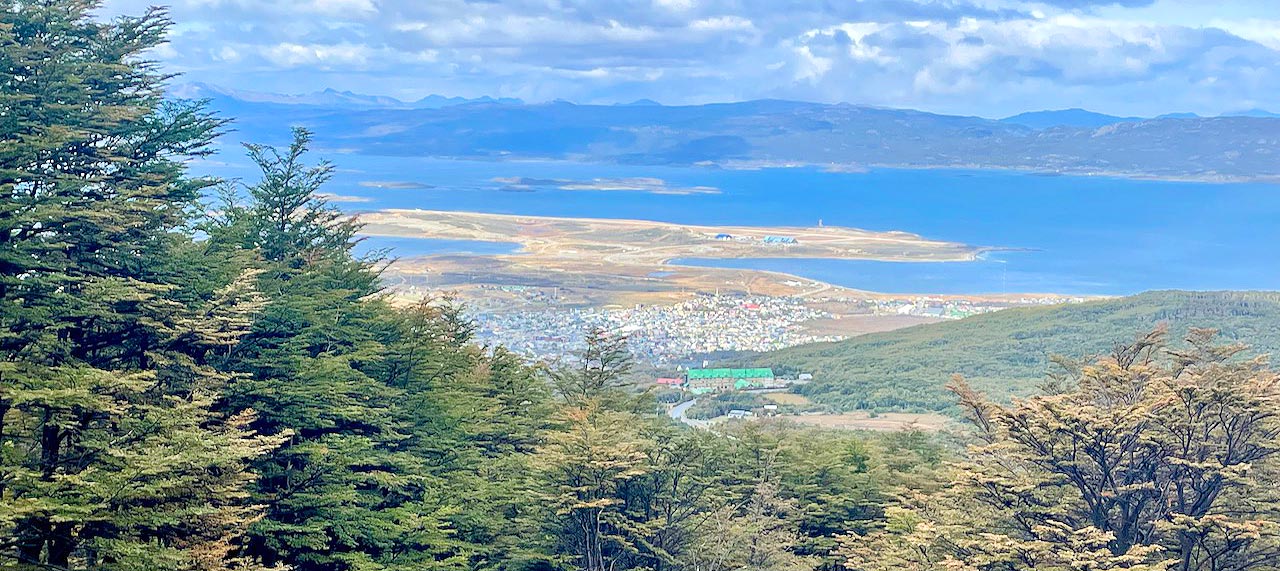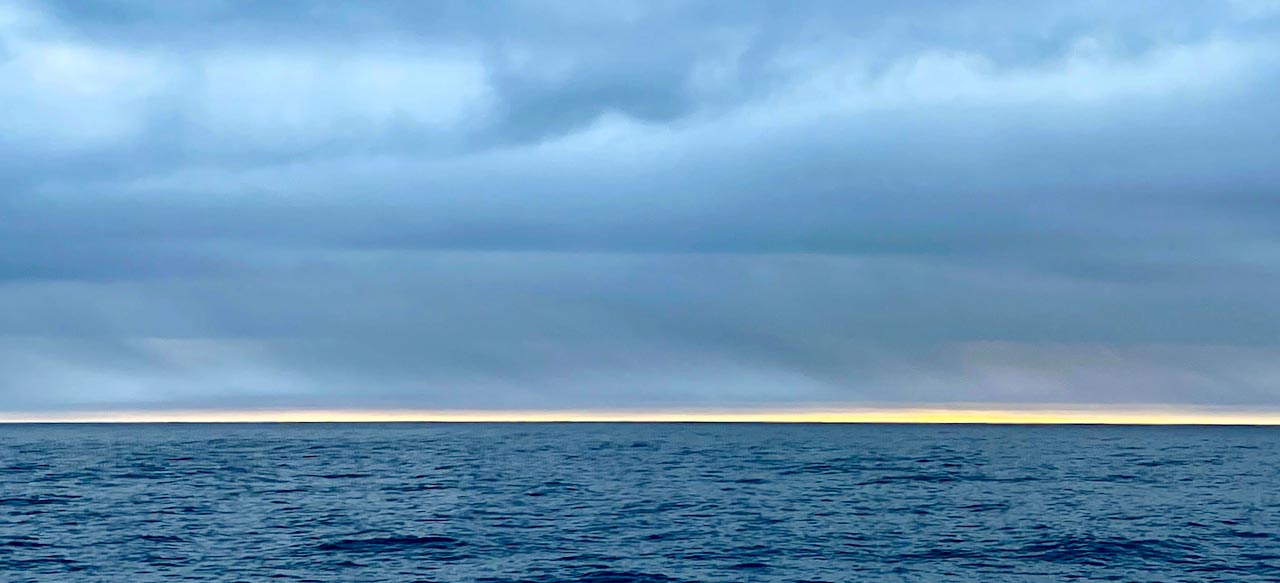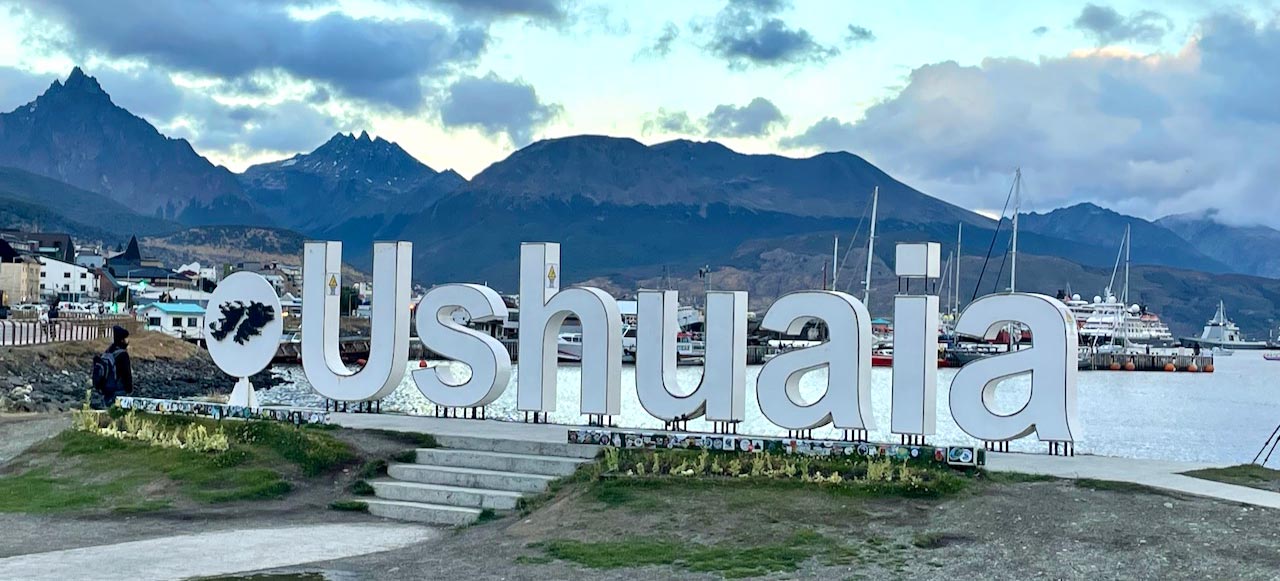Ushuaia and the Drake Passage
Voyage to Antarctica Part 1: This blog is part of a series from the owner and manager of Expeditions Online, Stewart Campbell, who travelled on our Antarctica Small Ship Expedition earlier this month. In the series Stewart documents the voyage and explores what is a typical experience on a Classic Antarctica cruise itinerary to the Antarctic Peninsula, with reflections on the advantages of small ship travel.
 A Voyage to Antarctica Part 1:
A Voyage to Antarctica Part 1:
Ushuaia… the ‘End of the World’
Like most people on the aircraft, I have travelled from far across the world. Even just this last Aerolineas Argentinas flight from the capital Buenos Aires is over three hours – Argentina is a big country! We flew over the flat pampas and then past the majestic Andes – just here in Patagonia is truly where the mountains meet the sea. As we descend towards Ushuaia, we fly amidst spectacular mountain peaks, scudding clouds, following the length of the wave-chased Beagle Channel. Passengers all clap with relief and excitement after the slightly bumpy ride. The bottom of the world so they say - but I am going further!
Bustling Ushuaia is the rapidly growing capital of Argentine Province of “Tierra del Fuego, Antártida e Islas del Atlántico Sur”. Ushuaia is really the biggest gateway to Antarctica and most common home port for cruise ships traveling to Antarctica and the Southern Ocean. Regarded as the southernmost city in the world, Ushuaia sits at the edge of a wide bay on the coast of the island of Tierra del Fuego, bounded on the north by the Martial Mountain range and on the south by the Beagle Channel. The name Ushuaia comes from the language of the Yámanas or Yaghanes, its original inhabitants, and means “bay that penetrates westward”. The city foundation was in 1884 when an Argentine expedition arrived to establish a sub-prefecture. However, some 300 Anglican missionaries already populated the area.
Since I first visited Ushuaia more than 30 years ago, I can see many changes. It still retains the feeling of a small frontier town, however, is really a small city with a thriving economy, boosted by the Antarctic tourism industry and generous tax policies by the Argentine government. The population has grown to more than 80,000, with new airport, whole new districts and features many hotels of all standards, a casino and even a Hard Rock Café! There are several attractions such as the Museum at the End of the World with its exhibits of Yámana, English, and Argentine settlement, including its early years as a prison colony. Local tours take you to see wildlife on the Beagle Channel, including a Magellanic penguin colony, on hiking trails or in the winter, there are small ski resorts. Restaurants famously feature delicious king crab on the menus and there are oodles of outdoor clothing, adventure sports and souvenir shops. But there is still only really one main street and the outlooks to the adjacent Beagle Channel as well as the precipitous, snow-capped mountains just behind remain just as spectacular and wild as ever.
Even though I have primarily travelled to visit Antarctica, the Patagonia and Ushuaia region is very attractive on its own, so I arrived a couple of days early to do some local sightseeing – as well as avoid any potential problems such as flight delays or missing baggage. It’s a precaution we recommend to all Antarctic travellers before what is very often their trip of a lifetime!
Weather changes rapidly in this part of the world and even in summer you can expect all seasons in one day! Wild, wind-blown sleet and rain showers greet the early morning but pass just as quickly. Shades of grey hiding the mountains are replaced by shots of sunshine, greens and blues and rewarding sights of the glaciers overhead. It’s usually rather breezy here and the day turns into a fine one, with sunshine and blue sky. I head off into the Tierra del Fuego National Park for a day of sightseeing and light trekking.

Enchanting lenga beech (nothofagus) forests with dense, moss-covered, and gnarly limbs tightly line the unsealed road which take us through the national park. These forests are a unique and diverse ecosystem of deciduous and evergreen trees which grow in the southern regions of Argentina and Chile. Bright green now in the summer, they are also known for their vibrant fall foliage, which turns rich shades of red, orange, and yellow during the autumn season. The forests are also home to a rich understory of shrubs, ferns, and other plants that thrive in the cool, moist climate. They are important habitats for a variety of wildlife, including mammals such as the Andean deer, the South American grey fox, Andean mountain cat, as well as many bird species.
A popular highlight in this area is the so-called ‘Train at the End of the World’, which is an historic narrow-gauge railway through the National Park with views of snow-capped peaks, forests, rivers and lakes. It was originally built to transport prisoners to forest work sites in the early 20th century.
The Martial Glacier is another popular tourist destination located right behind Ushuaia, with its many hiking trails easily accessible by a short taxi ride from the city. I clamber up along mountain streams and scree slopes towards the top. Having diminished somewhat due to the effects of climate change, the glacier itself is not quite the measure of some other Patagonian glaciers such as Perito Moreno, however the Martial is anyway quite a spectacular sight, featuring a field of ice surrounded by rugged peaks and valleys. The rather steep trek to the glacier's edge offers stunning views of Ushuaia and the Beagle Channel. Way down there in the distance, my ship was waiting!
Embarkation Day at the Port of Ushuaia: Ships in dock - small and LARGE
For those of you who wonder what it’s like to join a cruise to Antarctica in Ushuaia, the port is really very close by and visible, since the main pier jots out into the Beagle Channel directly in front of the town. From any hotel in downtown, it is an easy walking distance, although in some cases various ships might include a hotel night up the mountain with bus transfers down to the pier. In our case it was a short and simple stroll past the Tourist Office and onto the wharf and very first in line was our waiting small vessel, the Ocean Nova. Docked just behind are several other vessels which all look utterly enormous – all from 200 passengers and upward. I am sure they are all very nice in their way, however not my style and I infinitely prefer the ‘luxury of small’.
 In an age of ever-increasing size when it comes to expedition vessels, Ocean Nova is one of the last genuinely small ships making cruises to Antarctica. When I first began in this industry in the 1990s, most ships were 100 passengers or less and now there are hardly any left. It is actually a very important consideration when choosing a trip to Antarctica, since there remain very tight rules about how many people can go ashore simultaneously – maximum 100.
In an age of ever-increasing size when it comes to expedition vessels, Ocean Nova is one of the last genuinely small ships making cruises to Antarctica. When I first began in this industry in the 1990s, most ships were 100 passengers or less and now there are hardly any left. It is actually a very important consideration when choosing a trip to Antarctica, since there remain very tight rules about how many people can go ashore simultaneously – maximum 100.
Our ship Ocean Nova was built in 1992 for the ice-choked Greenland waters and fully refurbished in 2006 for Antarctica cruises. She has a clean, Scandinavian style and makes a truly ideal expedition vessel, carrying just 71 passengers - a huge advantage when it comes to flexibly being able to land everyone all at the same time. Fewer numbers is always preferable when it comes to wilderness areas and to maximise the potential of shore time.
Once on board, there is a sudden welcome and meeting of many new people from all corners of the world – and our enthusiastic and knowledgeable expedition team. The atmosphere is immediately relaxed and friendly. Up in the panorama lounge on top of the ship (with fantastic views in all directions) we have an introduction to our many guides and Captain to welcome us on board. There is a palpable feeling of happiness and relief as everyone realises they will be both safe and comfortable in our new floating home, yet at the same time, excitement that we are out together for the next ten days on a special adventure!

The Beautiful Beagle
Excitement builds even further as we release lines and sail out into the Beagle Channel, watching the city recede and admiring beautiful nature and mountains all around. The Beagle is a narrow passage in the archipelago of Tierra del Fuego, partly belonging to Chile and partly to Argentina.
Together with the Straits of Magellan to the north and the Drake Passage to the south, the Beagle is one of the three navigable passages in South America, connecting the Pacific and Atlantic Oceans. It is about 240km (150mi) long and about 5km (3mi) wide at its narrowest point and will take us about six hours to sail out. The channel was named after the ship HMS Beagle led by captain FitzRoy and with the famous naturalist Charles Darwin during the first hydrographic survey of the coasts of the southern South America, during 1826-30.

Already within the first hour of our voyage and still inside the channel, we are rewarded by our very first whale sighting of the voyage, followed by several Peale’s dolphins bow-riding nest to the ship, as well as many albatross and giant petrels and other seabirds. In the late afternoon sunshine, literally thousands of fulmars and petrels teem past us, returning to nesting grounds on small islands. Conversation buzzes in the dining room, and everyone is very pleasantly delighted and surprised at the high standard of hospitality and food with which our little ship is clearly going to treat us. Watch out waistline!
Trepidation mounts a little bit however as we approach the Drake Passage. It is calm of course here in the channel, but our leader reminds us that the worst to come will be in the early hours of the night. For some it is time to put on the motion sickness patches and get an early bedtime. Beautiful starry skies and following winds accompany us out and then around midnight we turn right, out into the open sea and Drake Passage, with its constant westerly winds and swell…
The Dreaded Drake
The Drake Passage is the body of water between the southern tip off South America at Cape Horn and the South Shetland Islands of Antarctica. It connects the southwestern part of the Atlantic Ocean (Scotia Sea) with the southeastern part of the Pacific Ocean and extends into the Southern Ocean. The passage receives its name from the 16th century English privateer Sir Francis Drake. Having passed through the Strait of Magellan, his ship was blown far South in September of 1578. This incident implied an open connection between the Atlantic and Pacific oceans. It is a notoriously rough stretch of ocean.

A rocky, rolly, lumpy and windy morning on the dreaded Drake! It could be worse as they say - although most people did not exactly have such a great night’s sleep! However, outside there are wandering albatross and other seabirds accompanying the ship and it is a great moment to pull out the binoculars and camera on the aft deck. During the afternoon the sun breaks through and the winds begin to abate. By evening time, the conditions are noticeably better. Happy conversations resume in the dining room and lounges as the anticipation builds. This is the time when I see people start to relax and enter the ‘expedition bubble’. Lectures commence, with talks on whales and geography kicking off the program during our first sea day. So enthusiastic and professional are our expedition team! It rouses the enthusiasm of quite a few budding amateur scientists, and we will have the opportunity to participate in various citizen science programs offered by the ship, such as counting birds to eBird–SeabirdSurveys, reporting whale sightings and images to HappyWhale, experiments to SecchiDisk measuring phytoplankton in the ocean.

Arriving Soon in Antarctica…
Our second day at sea and we not only have our sea legs by now but are also getting to enjoy the ‘Drake Lake’, with much calmer seas. We have entered the political region of Antarctica, governed by the Antarctic Treaty System covering all land, water and ice shelves south of 60° S. It is noticeably cooler as the water temperature drops abruptly and we pass the Antarctic Convergence, also known as the Antarctic Polar Front, which is an important oceanographic boundary, separating the more temperate waters to the north from the colder, nutrient-rich waters to the south. It is an unique ecosystem where a variety of marine organisms can thrive, including krill, squid, and a variety of fish, seals, and whales that rely on these organisms for food.
Further lectures and briefings help prepare us for tomorrow, which we hope will be our long-awaited first landing in Antarctica – who knows what the day will bring!?!
To be continued in Part 2…
Expeditions Online Newsletter
Sign up to be an Expeditions Online insider and receive info on exclusive deals, discounts and more!
 A Voyage to Antarctica Part 1:
A Voyage to Antarctica Part 1: